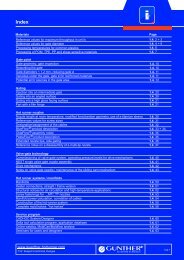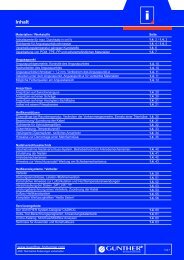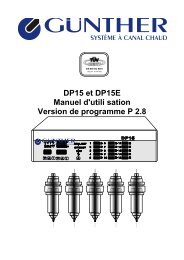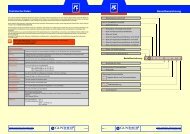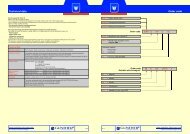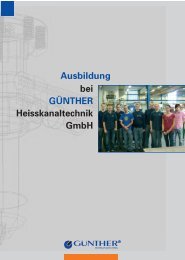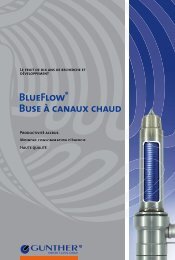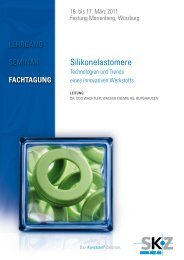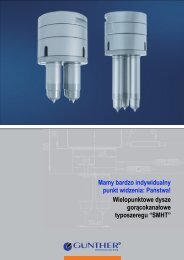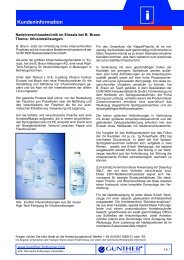Heißkanaldüsen Typ SLT/-DLT Customer information
Heißkanaldüsen Typ SLT/-DLT Customer information
Heißkanaldüsen Typ SLT/-DLT Customer information
Create successful ePaper yourself
Turn your PDF publications into a flip-book with our unique Google optimized e-Paper software.
<strong>Heißkanaldüsen</strong> <strong>Customer</strong> <strong>information</strong> <strong>Typ</strong> <strong>SLT</strong>/-<strong>DLT</strong><br />
Hot runner systems for plastics filled with<br />
metal or ceramic powders<br />
The MIM (Metal Injection Molding) and CIM (Ceramic<br />
Injection Molding) technologies use injection molding<br />
process to produce metal and ceramic components<br />
which could not, or only with considerably more effort, be<br />
produced by machining. With these methods threedimensional<br />
components, e.g. for medical engineering<br />
products, can be molded in only one working step with no<br />
need of subsequent machining. Without well adapted hot<br />
runners it is hardly possible to ensure manufacturing<br />
process reliability.<br />
Metal and ceramic powder filled plastics are used in<br />
many different fields. Examples of use of MIM are<br />
components for consumer products like ballpoint pens or<br />
for medical engineering products. Products<br />
manufactured by CIM are in demand where ceramics are<br />
required for insulation, often in conjunction with high<br />
temperatures. Sample applications can be found in the<br />
lighting industry. Both of the processes are relatively<br />
easy to use and make it possible to produce components<br />
without subsequent machining. Complex components<br />
can be manufactured this way.<br />
An application example for the MIM technology is an<br />
implantable infusion pump used in pain management for<br />
chronically ill patients. This device, installed in the<br />
abdominal wall, is applied for the measured dispensing<br />
of pain medication into the human body.<br />
The base plate was formerly manufactured by machining<br />
from a special, relatively expensive titanium alloy. This<br />
method was not only time-consuming but also expansive<br />
because of swarf. However, to realize the idea of<br />
manufacturing this component by MIM was not so easy<br />
at the beginning. Although it is normally quite easy to<br />
manufacture three-dimensional components by injection<br />
molding, the difficulty in this case was that the base plate<br />
had a large diameter and significant changes in wall<br />
thickness.<br />
This problem has been solved by injection molding the<br />
component with three parallel hot runner nozzles. It has<br />
resulted in short flow paths and more even pressure<br />
distribution to yield a component which is manufactured<br />
in only one working step without the necessity of<br />
subsequent machining. Lower production costs are yet<br />
another compelling factor.<br />
With the MIM and CIM processes, a metal or ceramic<br />
powder is mixed with a binding agent, often polyethylene<br />
or polyoxymethylene, and a special wax, and then<br />
granulated.<br />
This mixture, called a "feedstock", can be processed by<br />
injection molding like any conventional plastic material.<br />
The plastic material is then removed from the molding,<br />
the so-called "green part", by heating. After debinding,<br />
this component has a porous structure because of the<br />
removal of the plastic material and is called the "brown<br />
part".<br />
By sintering of this brown part the metal and ceramic<br />
constituents are baked together to form a component<br />
with a homogeneous structure whose density and<br />
resistance does not differ from a conventionally<br />
manufactured steel or ceramic component.<br />
The advantages of e.g. a metal component, like high<br />
mechanical resistance and high conductivity, are<br />
combined with a relatively simple way of manufacturing.<br />
For any questions, please contact our Application Engineering department at + 49 (0) 6451 5008-31 or -63.<br />
The <strong>information</strong> is given in accordance with our present-day knowledge and is meant to provide technical background.<br />
www.guenther-hotrunner.com<br />
7/12 Subject to technical changes<br />
iA<br />
Picture: The titanium alloy base plate (below) of an implantable<br />
infusion pump was formerly manufactured by a complex<br />
machining process. Today the MIM technology allows for scrap-free<br />
manufacturing without subsequent machining. (Photo: TiJet)<br />
1.5. 16



